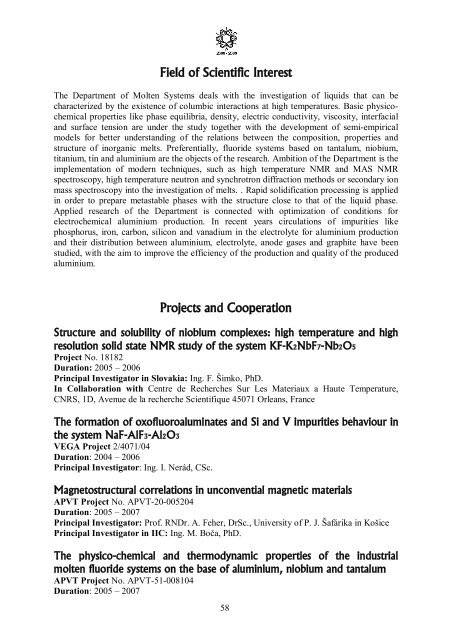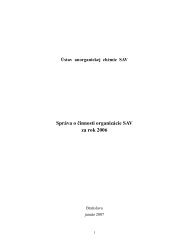Foreign Cooperating Institutions - Institute of Inorganic Chemistry ...
Foreign Cooperating Institutions - Institute of Inorganic Chemistry ...
Foreign Cooperating Institutions - Institute of Inorganic Chemistry ...
You also want an ePaper? Increase the reach of your titles
YUMPU automatically turns print PDFs into web optimized ePapers that Google loves.
Field <strong>of</strong> Scientific Interest<br />
The Department <strong>of</strong> Molten Systems deals with the investigation <strong>of</strong> liquids that can be<br />
characterized by the existence <strong>of</strong> columbic interactions at high temperatures. Basic physicochemical<br />
properties like phase equilibria, density, electric conductivity, viscosity, interfacial<br />
and surface tension are under the study together with the development <strong>of</strong> semi-empirical<br />
models for better understanding <strong>of</strong> the relations between the composition, properties and<br />
structure <strong>of</strong> inorganic melts. Preferentially, fluoride systems based on tantalum, niobium,<br />
titanium, tin and aluminium are the objects <strong>of</strong> the research. Ambition <strong>of</strong> the Department is the<br />
implementation <strong>of</strong> modern techniques, such as high temperature NMR and MAS NMR<br />
spectroscopy, high temperature neutron and synchrotron diffraction methods or secondary ion<br />
mass spectroscopy into the investigation <strong>of</strong> melts. . Rapid solidification processing is applied<br />
in order to prepare metastable phases with the structure close to that <strong>of</strong> the liquid phase.<br />
Applied research <strong>of</strong> the Department is connected with optimization <strong>of</strong> conditions for<br />
electrochemical aluminium production. In recent years circulations <strong>of</strong> impurities like<br />
phosphorus, iron, carbon, silicon and vanadium in the electrolyte for aluminium production<br />
and their distribution between aluminium, electrolyte, anode gases and graphite have been<br />
studied, with the aim to improve the efficiency <strong>of</strong> the production and quality <strong>of</strong> the produced<br />
aluminium.<br />
Projects and Cooperation<br />
Structure and solubility <strong>of</strong> niobium complexes: high temperature and high<br />
resolution solid state NMR study <strong>of</strong> the system KF-K2NbF7-Nb2O5<br />
Project No. 18182<br />
Duration: 2005 – 2006<br />
Principal Investigator in Slovakia: Ing. F. Šimko, PhD.<br />
In Collaboration with Centre de Recherches Sur Les Materiaux a Haute Temperature,<br />
CNRS, 1D, Avenue de la recherche Scientifique 45071 Orleans, France<br />
The formation <strong>of</strong> ox<strong>of</strong>luoroaluminates and Si and V impurities behaviour in<br />
the system NaF-AlF3-Al2O3<br />
VEGA Project 2/4071/04<br />
Duration: 2004 – 2006<br />
Principal Investigator: Ing. I. Nerád, CSc.<br />
Magnetostructural correlations in unconvential magnetic materials<br />
APVT Project No. APVT-20-005204<br />
Duration: 2005 – 2007<br />
Principal Investigator: Pr<strong>of</strong>. RNDr. A. Feher, DrSc., University <strong>of</strong> P. J. Šafárika in Košice<br />
Principal Investigator in IIC: Ing. M. Boča, PhD.<br />
The physico-chemical and thermodynamic properties <strong>of</strong> the industrial<br />
molten fluoride systems on the base <strong>of</strong> aluminium, niobium and tantalum<br />
APVT Project No. APVT-51-008104<br />
Duration: 2005 – 2007<br />
58



